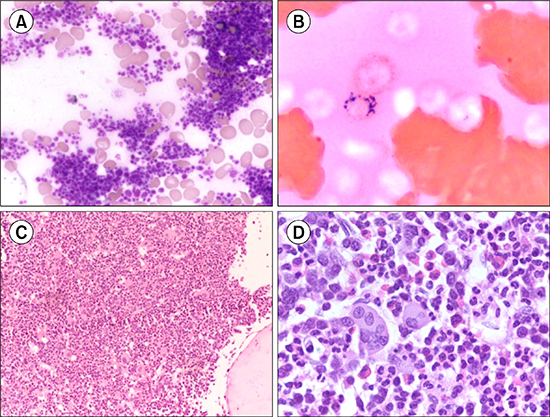
A 58-year-old man presented with a 1-year history of transfusion-dependent anemia. On examination, he had pallor and his spleen was barely palpable. A complete hemogram showed the following: hemoglobin, 5.4 g/dL; mean corpuscular volume, 114.1 fL; mean corpuscular hemoglobin, 34.6 pg; mean corpuscular hemoglobin concentration, 30.3 g/dL; total leucocyte count, 4.1×109/L; and platelet count, 867×109/L. A blood differential count showed 40% neutrophils, 54% lymphocytes, 2% monocytes, and 3% eosinophils. A peripheral blood smear showed dimorphic red cells, marked thrombocytosis, and platelet anisocytosis (A). His serum vitamin B12 level was 400 pg/mL. A bone marrow aspiration showed mild dyserythropoiesis and dysmegakaryopoiesis, while a pearl stain for iron showed >15% ringed sideroblasts (B). A bone marrow trephine biopsy showed megakaryocytic hyperplasia, focal clustering of megakaryocytes (C), and hyperlobated megakaryocytes (D). Conventional karyotyping showed a normal male karyotype. A diagnosis of refractory anemia with ring sideroblasts and thrombocytosis (RARS-T) was made, and the patient was kept under follow-up observation. RARS-T is a new, provisional entity that belongs to the unclassifiable category of myelodysplastic/myeloproliferative neoplasm syndromes and demonstrates both morphological features of RARS, along with thrombocytosis (platelet count >450×109/L) and evidence of hyperlobated megakaryocytes. The presence of myeloproliferative component is also highlighted by the fact that the majority of cases are associated with presence of JAK2 mutations. Therefore, a high degree of suspicion is needed to properly diagnose these rare overlap syndromes, which show features that are common to both myelodysplastic and myeloproliferative neoplasms.




 PDF
PDF ePub
ePub Citation
Citation Print
Print


 XML Download
XML Download